June 2009 LIP of the Month
Snake River Plain Igneous Province (12 Ma through 0 Ma)
John W. Shervais
Department of Geology, Utah State University, Logan, Utah 84322-4505, USA; john.shervais@usu.edu
Barry B. Hanan
Department of Geological Sciences, San Diego State University, San Diego, California 92182-1020, USA; bhanan@mail.sdsu.edu
Based on the Following Papers:
Shervais, JW and Vetter, SK, 2009, High-K Alkali Basalts of the Western Snake River Plain: Abrupt Transition from Tholeiitic to Mildly Alkaline Plume-Derived Basalts, Western Snake River Plain, Idaho, Journal of Volcanology and Geothermal Research, doi:10.1016/j.jvolgeores.2009.01.023.
Shervais, J.W., and Hanan, B.B., 2008, Lithospheric topography, tilted plumes, and the track of the Snake River-Yellowstone Hotspot, Tectonics, 27, TC5004, doi:10.1029/2007TC002181.
Hanan, BB Shervais, JW, and Vetter, SK, 2008, Yellowstone plume-continental lithosphere interaction beneath the Snake River Plain, Geology, v. 36, 51-54. DOI: 10.1130/G23935A.1
Shervais, J.W., Vetter, S.K. and Hanan, B.B., 2006, A Layered Mafic Sill Complex beneath the Eastern Snake River Plain: Evidence from Cyclic Geochemical Variations in Basalt, Geology, v. 34, 365-368.
Shervais, J.W., Kauffman, J.D., Gillerman, V.S., Othberg, K.L., Vetter, S.K., Hobson, V.R., Meghan Zarnetske, M., Cooke, M.F., Matthews, S.H., and Hanan, B.B., 2005, Basaltic Volcanism of the Central and Western Snake River Plain: A Guide to Field Relations Between Twin Falls and Mountain Home, Idaho; in J. Pederson and C.M. Dehler, Guide to Field trips in the western United States, Field Guide volume 6, Geological Society of America, Boulder Colorado, 26 pages.
Shervais, J.W., Shroff, G., Vetter, S.K., Matthews, S., Hanan, B.B., and McGee, J.J., 2002, Origin of the western Snake River Plain: Implications from stratigraphy, faulting, and the geochemistry of basalts near Mountain Home, Idaho. in Bill Bonnichsen, C.M. White, & Michael McCurry (eds) Tectonic and Magmatic Evolution of the Snake River Plain Volcanic Province, Idaho Geological Survey Bulletin 30, Moscow, Idaho, 343-361.
Introduction
The Yellowstone-Snake River Plain (YSRP) volcanic system, which began ≈17 Ma under eastern Oregon and northern Nevada and is currently active under the Yellowstone Plateau, is the world’s best modern example of a time-transgressive hotspot track beneath continental crust (figure 1). The Yellowstone Plateau consists largely of rhyolite with few mantle-derived basalts (Christiansen 2001). The Snake River Plain (SRP) volcanic province, which represents the earlier track of the Yellowstone hotspot, consists of basalts that are compositionally similar to ocean island basalts like Hawaii and overlie rhyolite caldera complexes that herald the onset of plume-related volcanism (e.g., Smith and Braile 1994; Pierce et el 2002). The SRP preserves a record of volcanic activity that spans over 12 Ma and is still active today, with basalts as young as 2000 years old. Thus, the Snake River volcanic province represents the archetype example of active time-transgressive intra-continental plume volcanism. The SRP is unique because it is relatively undisturbed tectonically and because it contains a complete record of volcanic activity associated with passage of the hotspot or mantle plume. Although plumes were originally thought to consist of thin vertical tails that feed a bulbous plume head (e.g. Olson et al 1987; Olson 1990), recent numerical models suggest that deep mantle plumes may have complex geometries that are not continuous from top to bottom, and may be tilted by flow of the asthenosphere (e.g., Farnetani & Samuel 2005). Seismic tomography confirms these predictions for the Yellowstone plume (Yuan & Dueker 2005; Waite et al 2006; Smith et al 2007).
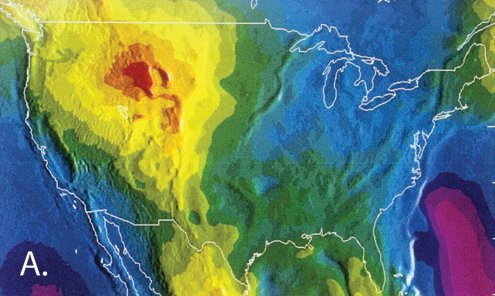
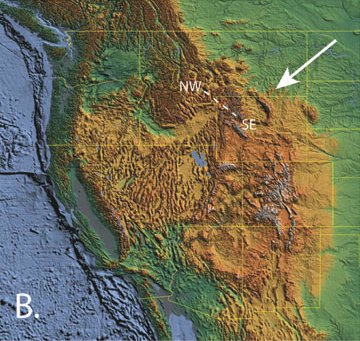
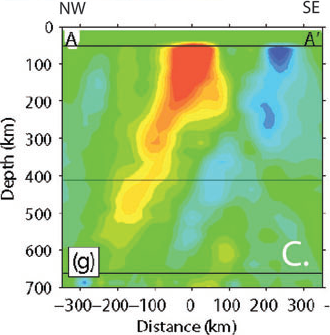
Figure 1: Impact of the Snake River-Yellowstone plume on North America. (A) Geoid map of North America, showing prominent positive geoid anomalie of +15 m centered on current location of Snake River-Yellowstone hotspot. (B) digital topographic map which shows effect of the plume tail on topography, cutting across the regional Basin & Range trend to form a broad depression approximately 100 km across and several hundred km long. White arrow shows direction of North American plate motion, dashed white line shows approximate location of seismic tomograph section in figure 1C. (C) Seismic tomograph of Yellowstone thermal anomaly; anomaly plunges approximately 65º WNW (plane of section). Note the high velocity (cold) lithospheric root of Wyoming craton, which extends to at least 300 km depth SE of the thermal anomaly. Tomograph from Yuan and Dueker, 2005.
Recently, the concept of mantle plumes as thermally or compositionally distinct entities has been challenged (e.g. Anderson 2001; Christiansen et al 2002; Foulger & Natland 2003; Foulger et al 2004). Evidence cited in favor of a non-plume origin include the structure of the subcontinental lithosphere beneath the eastern SRP trend (Humphreys et al 2000; Christiansen et al 2002), the large component of lithospheric melt inferred from some isotopic studies of SRP basalts (Reid, 1995; Hart et al 1997; Leeman et al 2009), the occurrence of other ENE-trending lava fields in the southern Great Basin and Colorado Plateau (St George and the Jemez volcanic trends), and the WNW-trend of the Oregon High Plains lavas, which young to the NW (Jordan et al 2004). Many of these observations are consistent with both plume and non-plume models, and thus cannot be used to distinguish between hypotheses.
Alternative models that have been proposed for the origin of the SRP and its linear array of time-transgressive volcanic centers include edge-driven convection, where the drift of cratonic lithosphere creates an upwelling of asthenosphere along its margin (King and Anderson, 1995; King 2007), propagation of a lithospheric fracture due to plate motion (Christiansen et al 2002), and as a convective roll or ‘hotline’ within the sublithospheric conduit driven by pressure release melting of the convecting asthenosphere (Saltzer and Humphreys, 1997). The edge-driven convection and ‘hotline’ models are both based on the observation that partial melting will create a convective instability by decreasing density in the molten mantle; this will drive further pressure release of subjacent mantle, which will melt and cause more pressure release melting. This ‘positive feedback loop’ will continue until lateral differences in density (e.g., with the melting residue) become too small to drive the system.
Regional Setting
The Neogene Snake River volcanic province can be divided into three subprovinces: (1) the older western province, comprising the Owyhee Plateau and western SRP graben, (2) the transitional central SRP, including the Bruneau-Jarbidge eruptive center, and (3) the younger NE-trending eastern SRP. The relatively well-studied eastern SRP, which trends parallel to North American plate motion (Pearce et al 2002; Gripp and Gordon 2002), is characterized by a thin (≤1.5 km) carapace of basalt that overlies rhyolites extending to depths >3 km (e.g., Champion et al 2002). The eastern SRP is underlain by a 10 km thick mid-crustal density anomaly, imaged seismically, that is interpreted to represent a basaltic sill (Peng & Humphries 1998). Studies of core from deep drill holes in the eastern SRP show that the basalts form a series of upward fractionation cycles and reversed cycles that indicate fractionation in a magma system undergoing periodic recharge; we infer that this fractionation occurred in a sill complex of layered magma chambers represented by the mid-crustal density anomaly (Geist et al 2002; Shervais et al 2006). Chemical and isotopic variations show that the oldest basalts assimilated continental crust, but later basalts interacted largely with crystallized melts of the layered magma system, resulting in decoupling of major and trace element fractionation, but without substantial changes in isotopic composition (Shervais et al 2006). This has resulted in new model for basalt-crust interaction in continental systems that we call assimilation of consanguineous mafic intrusions (ACMI: Shervais et al 2006).
In the western province, the Owyhee Plateau is a highland underlain by rhyolite and basalt (Ekren et al 1984), whereas the western SRP is a NW-trending graben bounded by en-echelon normal faults and filled with several km of Pliocene-Pleistocene sediments deposited in large epicontinental lakes (Wood and Clemens 2002); deep drill core shows that the lake sediments are both underlain and overlain by basalt (Shervais et al 2002). The western province is underlain by a mid-crustal mafic sill similar to that imaged under the eastern plain (Hill and Pakiser, 1967; Prodehl, 1979), even though it lies north of the projected hotspot track based on reconstructions of North American plate motion (Gripp and Gordon, 2002). Younger basalts of the western SRP are coeval with Pleistocene basalts of the eastern SRP but are less voluminous and generally more Fe-rich (Vetter and Shervais, 1992; Shervais et al 2002; White et al, 2002). In addition, there is an abrupt and fundamental change in basalt compositions ≈700 ka, from Fe-rich tholeiitic basalts to K-rich transitional-alkaline basalts (Vetter & Shervais, 1992; Shervais et al 2002; White et al, 2002; Shervais and Vetter 2009). The K-rich basalts have trace element and isotopic systematics that are similar to the plume component in ocean island basalts such as Hawaii (Vetter and Shervais 1992) and represent an abrupt and fundamental change in magma source regions that has not been observed along the plume track farther east.
The central SRP represents a critical transition from the broad western province to the well-defined eastern province, but it has received comparatively little study (Fig 2). Surface basalts are generally < 1 Ma and form a thick axial volcanic zone of young volcanic vents (Shervais et al 2005). In the SE these basalts directly overlie rhyolite of the Twin Falls eruptive center; in the NW they overlie fluvial and lacustrine sediments similar to those found in the west, and older (Pliocene) basalts that rest on rhyolite (Fig 3). A 340 m drill core near Wendell (NW of Twin Falls) documents ≈1 Ma hiatus in basalt eruptions — shorter in duration and younger than the hiatus observed in the western SRP described above. This connection between basaltic volcanism in the western SRP graben and basaltic volcanism on the projected plume track implies that similar processes controlled the magmatic systems in both areas.
Sr-Nd-Pb isotopes suggest <5% lithospheric input into a system dominated by plume-derived basalts similar in composition to Hawaiian basalts. Isotopic studies of surface and subsurface basalt flows show systematic variations in Sr-Nd-Pb isotopes with distance from Yellowstone that are interpreted to reflect changes in the proportion of plume source and the underlying heterogeneous cratonic lithosphere, which varies in age, composition, and thickness from west to east (Hanan et al 2008).
Geophysical studies of the eastern SRP have documented differences in both the crustal structure and lithosphere/asthenosphere boundary relative to both the Archean Wyoming craton, and the Basin and Range province. The most important crustal feature observed in seismic reflection profiles of the eastern SRP is the 10 km thick mid-crustal sill (Sparlin et al 1982; Peng and Humphreys, 1998). In the mantle, seismic tomography of the lithosphere/asthenosphere boundary shows that SCLM directly beneath the SRP has been eroded to form a deep channel parallel to North American plate motion. Within this channel, a low-velocity zone of hot, partially molten asthenosphere is flanked by levees of high-velocity, melt-depleted mantle that has been plastered onto the walls of the channel (Saltzer and Humphreys 1997; Humphreys et al 2000). This work has been confirmed by Yuan and Dueker (2005) and Waite et al (2006) beneath the Yellowstone Plateau, where they document a ≈100 km diameter positive thermal anomaly plunging ≈65º NW and filling a channel in the lithosphere that does not continue NE of Yellowstone, but can be traced into the eastern SRP. This thermal anomaly extends through the mantle transition zone (≈700 km) but cannot be imaged below that depth (Smith et al 2007); it may end there, or be too narrow to image with current technology (e.g., Montelli et al 2006).
Major and Trace Element Processes in SRP Basalts
The major and trace element composition of continental basalts reflects the composition of their source region, the extent and depth of melting that produced them, subsequent interactions with the intervening mantle and crust, and magma chamber processes that modify their compositions prior to eruption. In order to understand the origin of basalt flows erupted onto the surface we must essentially work backwards, unraveling first the magma chamber processes and crustal interactions that affect their compositions, and then using the ‘corrected’ compositions to understand their prior mantle history.
Basalts of the Snake River volcanic province have major element compositions similar to ocean island basalts (OIB), with higher FeO, TiO2, P2O5 and K2O than mid-ocean ridge basalts over a similar range in MgO (figure 2). Their trace element concentrations also mimic OIB tholeiites (like Hawaii), with moderately enriched LREE/HREE ratios and OIB-like HFSE ratios (figure 4). Their compositions are distinct from sodic-alkaline rocks associated with extension in the Great Basin (Wise, 1969; Farmer et al 1995) and highly potassic rocks erupted through the Wyoming craton (e.g., Cenozoic: Luecite Hills, Vollmer et al 1984; Absaroka, Feeley et al 2002; Independence, Meen and Eggler 1987; Missouri Breaks, Scambos 1987; Smoky Butte, Fraser 1987; Bearpaw Mountains, MacDonald et al 1992; Highwood Mountains, O’Brien et al 1995). For the most part these rocks show little evidence of crustal assimilation: oxygen isotope compositions average around 5.8-6.0 ∂18O, K2O is relatively low and does not increase relative to other incompatible elements during fractionation (e.g., P2O5), and silica contents are consistently low (e.g., Leeman 1982; Vetter and Shervais 1992; Geist et al 2002; Hughes et al 2002; Kuntz et al 1992). In contrast, evidence suggests that these basalts evolve primarily through fractional crystallization in relatively shallow magma chambers (mid-crustal, 10-20 km) with episodic magma recharge (Geist et al 2002; Shervais et al 2006).
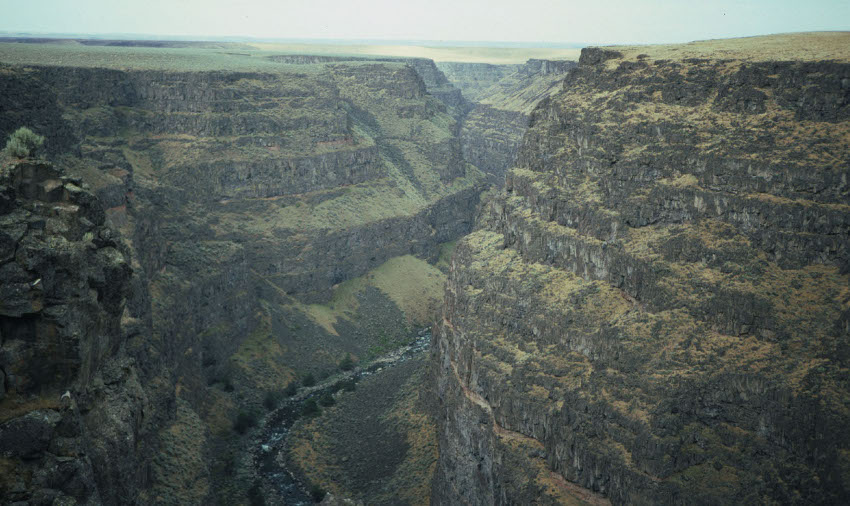
Figure 2: Flood basalts of the Snake River Plain exposed in Bruneau Canyon. Eleven major basalt flows with minor sedimentary interbeds.
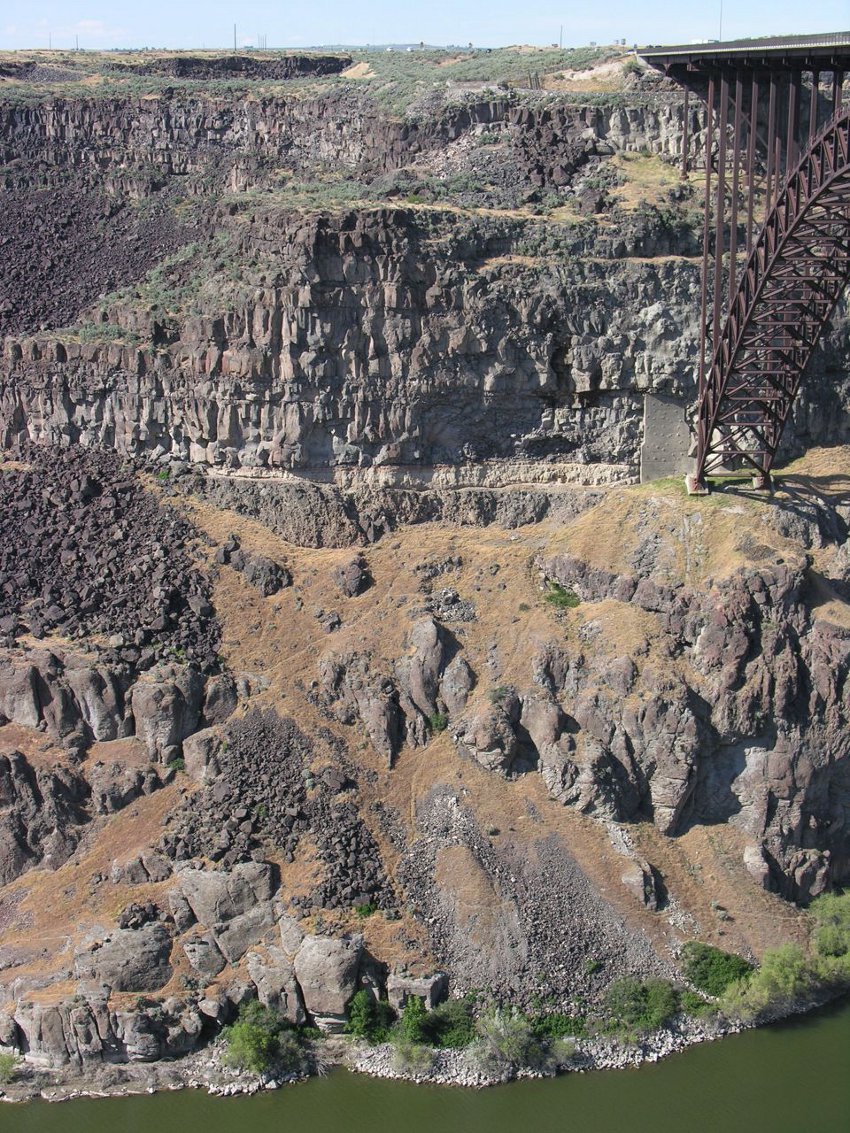
Figure 3: Volcanic stratigraphy at the Perrine Bridge, Twin Falls, Idaho. Dark rock at bottom of canyon is the 6.25 Ma Twin Falls rhyolite. The thickest section of basalt erupted from vents south of the river (Hub Butte, Sonnickson Butte), and is overlain by a thinner section of basalt from north of the current river (mostly Flat Top Butte with basalt of Rocky Butte and/or Wilson Butte) on top. Basalt and rhyolite are separated by thin wedges of clastic sediment in middle of section.
Our evidence to date suggests that crustal assimilation, when it is observed, occurs primarily within the mid-crustal magma chambers through the assimilation of low-percentage melting fractions (or residual melt fractions) of previously intruded mafic magmas (Geist et al 2002; Shervais et al 2006, 2007). This process, which we refer to as assimilation of consanguineous mafic intrusions (ACMI) is implied by following evidence: (1) increasing La/Lu with decreasing MgO, indicating an AFC process, (2) decreasing K/Ti and K/P ratios with decreasing MgO, indicating a low-K assimilant, and (3) radiogenic isotopes that remain essentially constant during this process (Shervais et al 2006; submitted). The first two are commonly observed in SRP basalts, suggesting that this process is relatively widespread within this province. Isotopic data are too sparse for most locations to document the third, but where these data exist the results are compelling (Shervais et al 2006). This means that for basalts that have not assimilated felsic crust, their isotopic compositions likely reflect their parent magma and not a mixture of parental and felsic crust components. Basalt fractionation trends allow us to reconstruct parental magmas with some confidence, which further allows us to investigate mantle processes.
Trace element concentration patterns are nearly identical to OIB tholeiites, with somewhat lower slopes on multi-element variations diagrams, consistent with 7-12% partial melting of spinel-facies peridotite (9-18 kb, 40-65 km) with a composition similar to the source of EMORB (Shervais et al 2006, Shervais and Vetter 2009). Our models show that NMORB or primitive mantle composition sources cannot yield SRP tholeiites, even with residual garnet in the source region to raise LREE/HREE ratios in the melt. There is no indication of residual garnet in the source – which requires that either the lithosphere was relatively thin (or had been removed by delamination or some other process) or that the melts originated within the lithosphere itself. As discussed in more detail below, the major element concentrations, trace element systematics, and isotopic compositions all favor a sub-lithospheric source for these magmas.
One of the most interesting aspects of SRP volcanism is the young high-K transitional alkaline basalts associated with the western SRP (Vetter and Shervais, 1992; Shervais et al 2002; White et al 2002; Shervais and Vetter 2009). These rocks are unusual because they are not only higher in K2O then SRP tholeiites, but also in silica, MgO, Cr, and Ni (Vetter and Shervais 1992). They are characterized by extremely low Zr/Nb and Y/Nb ratios that are essentially identical to the enriched ‘plume’ end member in the plume-OIB array and have isotopic compositions that are closer to Hawaiian plume than any basalts in the SRP; they correlate most closely with Hawaiian post-shield alkali basalts. Vetter and Shervais (1992) have shown that these compositions are not the result of crustal assimilation: they are more MgO-rich then the tholeiites, and have mantle oxygen isotope compositions (∂18O ≈ 5.8). These high-K alkaline lavas appear to represent the least contaminated component of the Yellowstone plume – yet they are only found in the western SRP, over 400 km west of the current position of the active plume. With ages of 200 ka to 700 ka (Howard et al 1982; White 2002), they were coeval with the youngest eruptive cycle of at Yellowstone, and post-dated the onset of plume-related volcanism in the west by more than 10 million years. Eruption of these ‘pure plume’ lavas with little or no lithospheric contamination requires that either ancient Archean-Proterozoic lithosphere was completely removed by thermal or mechanical erosion by the plume, or that this lithosphere was finally depleted in its low-temperature melting fraction so that subsequent transient magmas had little chemical interaction. We consider these unusual lavas to be an important consequence of plume–SCLM interaction along the SRP and perhaps a key to understanding the transition between Mesozoic and cratonic SCLM (Shervais and Vetter 2009). The abrupt transition from tholeiitic to alkaline volcanism at around 700 ka implies a rapid, perhaps catastrophic origin, such as lithospheric delamination caused by a Rayleigh-Taylor instability beneath the Idaho batholith (e.g., Elkins-Tanton 2007).
Isotope Fingerprinting of the SRP mantle Source
Correlations between He, Sr, Nd, Hf, Os and Pb isotope ratios are powerful indicators of mantle source origin of basaltic rocks. Isotope signatures of continental basalts, in comparison to oceanic lavas, are generally more difficult to interpret because of possible interactions with continental crust and/or sub-continental mantle lithosphere (SCML) components (e.g. Carlson et al 1981; Hart 1985; Hart et al 1989; Johnson and Beard 1993; Beard and Johnson 1993). In the Snake River Plain the limited range of major and trace element composition, mantle δ18O signatures, and lack of any correlation between 87Sr/86Sr (or δ18O, 206Pb/204Pb, and 208Pb/204Pb) and major and trace element, and rare earth element abundances in the basalts indicate minimal crustal interaction (Menzies et al., 1983; Leeman, 1982; Carlson, 1984; Hart, 1985; Church, 1985; Shervais et al., 2006). Major element, trace element, and He isotope systematics of the basaltic rocks are consistent with a deep, sublithospheric mantle source, similar to the source of ocean island basalts (e.g., Craig et al 1978; Vetter and Shervais 1992; Hughes et al 2002; Shervais et al 2006; Graham et al 2008). In contrast, the radiogenic Pb isotopes in these basalts are indistinguishable from melts derived from the ancient Wyoming cratonic lithosphere that underlies the SRP, while Sr and Nd isotope ratios are intermediate between depleted mantle and continental crust or lithospheric mantle values (Church 1985; Leeman et al 1985; Hughes et al 2002). This conundrum has been a major problem for plume models presented in the past.
Lithosphere beneath the Snake River Plain and Yellowstone Plateau stabilized in the Late Archean to Paleoproterozoic (Mueller and Frost 2006). Compared to other Late Archean rocks, the Pb and Sr initial ratios are higher, and the Nd initial ratios are lower, than expected for a depleted upper mantle source (Wooden and Mueller 1988; Menzies et al 1983). These isotope data, and mantle xenolith Os, Sr, Nd, and Pb isotopes (Carlson and Irving 1994), suggest that crustal material was mixed into the lithosphere during Late Archean subduction and later Proterozoic metasomatic events (Church 1985; Wooden and Mueller 1988). However, this enriched lithosphere is not conducive to preserving ancient high 3He/4He. An appropriate mantle with high time-integrated 3He/(U+Th) that would allow preservation of ancient 3He enrichments cannot exist within or below the continents, and is unlikely to exist within the upper mantle based on the 3He/4He in MORB (Day et al 2005). The high 3He of the Snake River–Yellowstone province suggests that there is a flux of deep mantle material across the 660 km mantle transition zone into the upper mantle plume imaged at Yellowstone (Waite et al 2006).
Hanan et al. (2008) proposed that the apparent conflict between the isotopic and major and trace element data can be resolved by considering mass balance between the contrasting components. The Pb, Sr, and Nd concentrations in the plume source are low compared to SCLM, and melts derived from the plume source are expected to have concentrations of Pb, Sr, and Nd on the order of 0.3–3, 90–660, and 7–40 ppm, respectively, based on observed concentrations in OIBs and on trace element melting models of inferred plume sources (e.g., Sun and McDonough 1989). In contrast, low percent fractional melts of ancient SCLM, such as the Leucite Hills volcanics (Vollmer et al 1984; Mirnejad and Bell 2006), are strongly enriched in Pb (23–120 ppm), Sr (1652−7233 ppm), and Nd (97−300 ppm), and provide an estimate for these concentrations in melts assimilated by the plume basalts as they rise through the lithosphere. The SCLM:plume proportions implied by these concentrations are ~38–400 for Pb, ~11–80 for Sr, and 11–41 for Nd. As a result, the assimilation of lithospheric melts into partial melts derived from plume-source mantle will result in hybrid magmas whose isotopic compositions are controlled by the isotopic composition of the Archean lithosphere.
This process is well illustrated quantitatively by mass balance calculations for the radiogenic isotopes of Pb assuming a lithosphere:plume concentration ratio of 100. Figure 5 shows the effects of mixing a plume component similar in Pb isotopes to the Steens basalts, the earliest Columbia River eruption, and to Pacific Mesozoic oceanic crust (e.g., Shervais et al 2005) with fractional melts derived from Archean lithosphere with Pb isotopic composition represented by the ca. 2.8 Ga isochron for the Beartooth Mountain igneous rocks (Wooden and Mueller 1988). Heterogeneity in the lithosphere is expected to be much greater than for the plume source. For ease in modeling and visualization we have chosen a single point located in the overlap between the Steens and Stonyford fields to represent the plume isotope composition. The Beartooth rocks are a good proxy for the Paleoproterozoic–Archean lithosphere because they show the whole range of 206Pb/204Pb isotope compositions observed in the Snake River Plain basalts and crustal xenoliths, the Saddle Mountain lavas, and the Yellowstone plateau basalts. Two effects are observed.
First, the mass fraction of plume component increases from east to west: Yellowstone ~95%–98%, eastern plain ~97%–98.5%, and central plain ~98%–99% plume component (figure 4). Second, the Pb isotopic composition of the lithospheric component changes from east to west: Yellowstone 206Pb/204Pb ≈15.5–17.0, central basalts 206Pb/204Pb ≈17.1–17.8, and eastern lavas 206Pb/204Pb ≈18.0–18.5 (Fig. 5). Modeling Snake River Plain basalt Sr and Nd isotopes using these end-member compositions gives results consistent with plume mass fractions >95% (figure 4B). These mass-balance models can be understood in terms of two processes. First, the increase in plume component from east to west most likely reflects a progressive decrease in the thickness of the cratonic lithosphere from east to west as the craton margin is approached. This decrease in thickness will result in a decrease in the volume of lithosphere available to react with the plume-derived melts, and hence a decrease in the proportion of lithosphere component assimilated. The depth of plume melting will also decrease, resulting in a higher degree of melting of the plume. Second, the regular increase in 206Pb/204Pb isotopic composition of the lithosphere component in the mix, from east to west, results from the concomitant decrease in lithosphere age and from compositional heterogeneity of the lithosphere. Spatial compositional differences are reflected by the lack of regular covariation between 208Pb/204Pb, 87Sr/86Sr, and 143Nd/144Nd ratios along the Snake River Plain (figure 5), corresponding to heterogeneity in Th/Pb, U/Pb, Rb/Sr, and Sm/Nd and the time-integrated effect of radioactive decay in the lithosphere. The similarity between the radiogenic isotope signatures of the Snake River Plain and the Saddle Mountain basalts, and their contrast to the Yellowstone basalts, indicates that the lithosphere between the Yellowstone Plateau and the craton margin is not the same as that underlying the Archean Wyoming province, but likely a transitional lithosphere containing a complex mixture of Archean and Proterozoic components (e.g., Foster et al 2006). In summary, Pb, Sr, and Nd isotopic analyses for basalts from the Snake River Plain, including the Idaho National Laboratory in the eastern plain, the Bruneau-Jarbidge eruptive center and the Glenns Ferry area, both in the central plain, show that these isotope compositions are compatible with a deep mantle plume source, which interacted with SCLM that varies in age, composition, and thickness from west to east, and are compatible with a mantle plume origin for the Snake River Plain basalts (Hanan et al 2008).
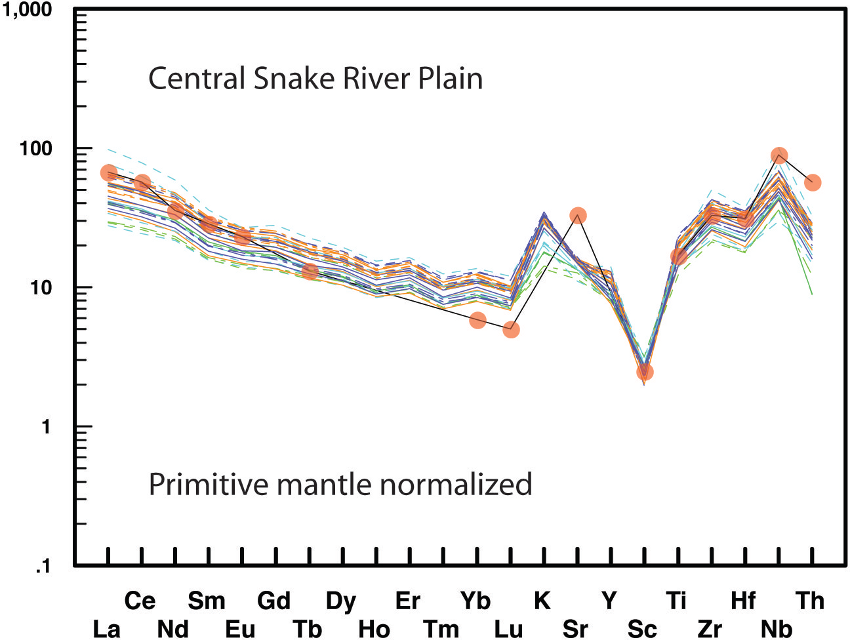
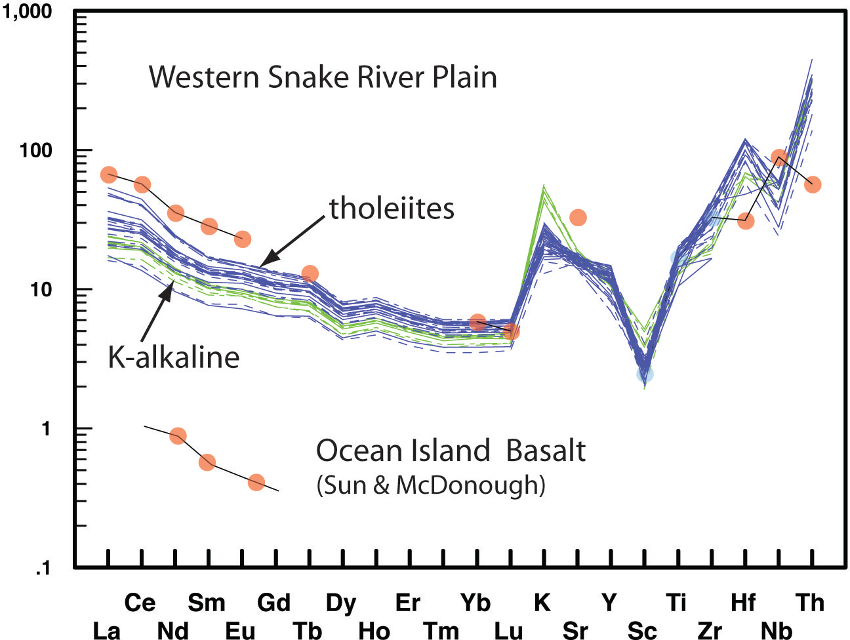
Figure 4: Multi-element spider diagrams normalized to primitive mantle for (A) tholeiitic basalts of the central SRP and (B) low-K tholeiitic basalts and high-K transitional alkaline basalts of western SRP, normalized to primitive mantle of Taylor and McLennan (1985). Both high-K and low-K basalts have OIB-like patterns; constant Sc and Sr in low-K basalts suggests cpx-rich source. Data from Vetter and Shervais (1992), White et al (2002), Shervais et al (2002, 2006), and Hughes et al (2002).
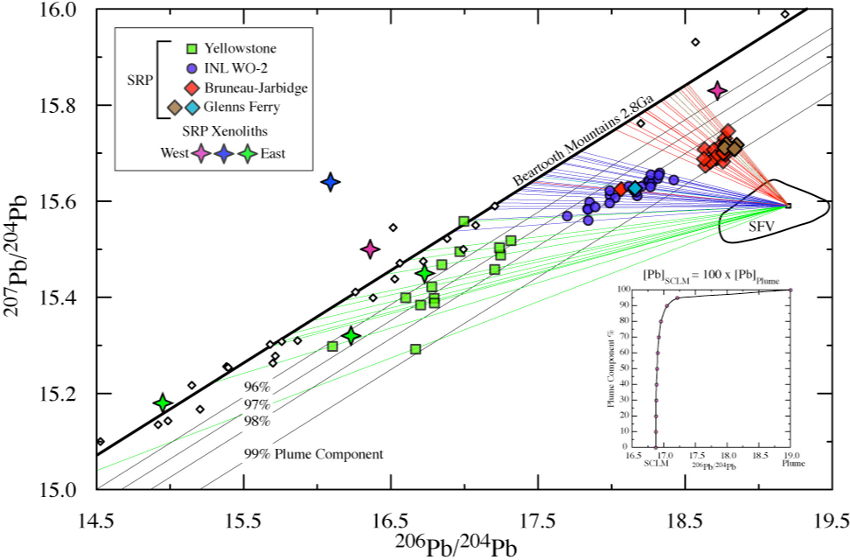
Figure 5: The 206Pb/204Pb and 207Pb/204Pb ratios for Yellowstone Plateau, Idaho National Laboratory (INL), Bruneau-Jarbidge, and Glenns Ferry lavas decrease from west to east. Isochron and data for Beartooth Mountains mafic igneous rocks (small open diamonds: Wooden & Mueller, 1988) represent Pb isotope composition of lithosphere underlying Yellowstone Plateau and Snake River Plain (SRP). Deep crustal xenoliths (Leeman et al 1985; Wolfe et al 2006) plot about the Beartooth 2.8 Ga isochron, and like the Snake River Plain basalts, the 206Pb/204Pb ratios of the xenoliths decrease from west to east. Field for the Columbia River Steens basalts and Stonyford Volcanic Complex (black line field labeled Plume; Camp & Hanan, 2008; Shervais et al., 2005) represents plume component. Red, brown, blue, and green lines represent mixing tie lines between average plume and distinct lithospheric Pb reservoirs along the Beartooth isochron for Snake River Plain and Yellowstone Plateau basalts. Solid lines labeled 95%–99% plume component indicate proportion of plume component in the basalt mixes where the lines intersect the tie lines. Note that Snake River Plain data define pseudo-isochrons with slopes lower than the 2.8 Ga Beartooth reference isochron. Inset plot shows mixing curve between enriched lithosphere with 206Pb/204Pb = 16.87and 207Pb/204Pb = 15.44 and plume source with 206Pb/204Pb = 19.0 and 207Pb/204Pb = 15.55. Pb concentration in the lithosphere is 100%– that of the plume. Note that with plume proportions >95% the isotope composition of the mix is dominated by lithosphere Pb signature. SCLM–subcontinental lithospheric mantle.
Seismic Tomography
Recent seismic tomography results document a low velocity anomaly that extends at 1000 km into the mantle below Yellowstone — but not completely continuous nor vertical (Xiu and Allen, 2007; James et al 2009). The data do not support the classic plume model with a vertical stem and a bulbous head, but are consistent with more recent models for thermochemical plumes (Farnetani and Samuel, 2005) and with evidence for non-fixed plumes. The seismic tomography data do support models that call for deep seated thermal and/or chemical anomalies to underlie mantle hotspots.
References
Anderson, DL, 2001, Mantle plumes? Science, 293, 2016.
Armstrong, RL, WP Leeman, and HE Malde, 1975, K–Ar dating, Quaternary and Neogene volcanic rocks of the Snake River Plain, Idaho, Am J Sci, 275, 225–251.
Beard, BL and CM Johnson, 1993, Hf isotope composition of late Cenozoic basaltic rocks from northwestern Colorado, USA; new constraints on mantle enrichment processes. Earth and Planetary Science Letters 119(4): 495–509.
Beard, BL and CM Johnson, 1997, Hafnium isotope evidence for the origin of Cenozoic basaltic lavas from the Southwestern United States. Journal of Geophysical Research, B, Solid Earth and Planets 102(9): 20,149–20,178.
Bonnichsen, Bill, and M.M. Godchaux, 2002, Late Miocene, Pliocene, and Pleistocene geology of southwestern Idaho with emphasis on basalts in the Bruneau–Jarbidge, Twin Falls, and western Snake River Plain regions, in Bill Bonnichsen, C.M. White, and Michael McCurry, eds., Tectonic and Magmatic Evolution of the Snake River Plain Volcanic Province: Idaho Geological Survey Bulletin 30, p. 233–312.
Camp VE, Hanan BB, 2008, A plume–triggered delamination origin for the Columbia River Basalt Group. Geosphere,. 4 (3) 480–495.
Carlson, RW and Hart WK, 1987, Crustal genesis on the Oregon Plateau: Jour of Geophysical Research, 92, no B7, 6191–6206.
Carlson, RW, 1984, Isotopic constraints on Columbia River flood basalt genesis and the nature of the subcontinental mantle: Geochimica et Cosmochimica Acta, 48, 2357–2372.
Carlson, RW, GW Lugmair, and JD McDougall, 1981, Columbia River volcanism: the question of mantle heterogeneity or crustal contamination, GCA 45, 2483–2499.
Champion, DE, Lanphere, MA, Anderson, SR, and Kuntz, MA, 2002, Accumulation and subsidence of the Pleistocene basaltic lava flows of the eastern Snake River Plain, Idaho, GSA Special Paper 353, 175–192.
Christiansen, RL, 2001, The Quaternary and Pliocene Yellowstone Plateau Volcanic Field of Wyoming, Idaho, & Montana, Geology of Yellowstone National Park, US Geol. Survey Prof Paper 729, 1–156.
Christiansen, RL, GR Foulger, JR Evans, 2002, Upper–mantle origin of the Yellowstone hotspot, GSA Bulletin; 114 (10) 1245–1256
Church, S.E., 1985, Genetic interpretation of lead–isotopic data from the Columbia River Basalt Group, Oregon, Washington, and Idaho: Geological Society of America Bulletin, 96, 676–690, doi: 10.1130/0016– 7606(1985)96<676:GIOLDF>2.0.CO;2.
Craig, H, Lupton, JE, Welhan, JA and Poreda, R, 1978, Helium isotope ratios in Yellowstone and Lassen Park volcanic gases. Geophys. Res. Lett., 5, 897–900.
Day, J.M.D., Hilton, D.R., Pearson, D.G., Macpherson, C.G., Kjarsgaard, B.A., and Janney, P.E., 2005, Absence of a high time–integrated 3He/(U+Th) source in the mantle beneath continents: Geology, 33, 733–736, doi: 10.1130/G21625.1.
Elkins–Tanton, LT, 2007, Continental magmatism, volatile recycling, and a heterogeneous mantle caused by lithospheric gravitational instabilities, J. Geophys. Res., 112, B03405, doi:10.1029/2005JB004072.
Farmer, GL, AF Glazner, HG Wilshire, JL Wooden, WJ Pickthorn, and M Katz, 1995, Origin of late Cenozoic basalts at the Cima volcanic field, Mojave Desert, California, J Geophys Res, 100(B5), 8399–8416.
Farnetani, CG, and H Samuel, 2005, Beyond the thermal plume paradigm, Geophys Res Lett, 32, L07311, doi:10.1029/2005GL022360.
Feeley, TC, Cosca, MA & Lindsay, CR, 2002. Petrogenesis and implications of cryptic hybrid magmas from Washburn volcano, Absaroka volcanic province, USA. Journal of Petrology 43, 663–703
Foulger G & Natland, 2003, Is Hotspot volcanism consequence of plate tectonics?Science, 300, 921–922.
Foulger, GR, Natland, JH, and Anderson, DL, 2004, Plume IV: Beyond the Plume hypothesis – tests of the plume paradigm and alternatives. GSA Today, 14, 26–28.
Fraser, KJ, 1987, Petrogenesis of kimberlite from South Africa and lamproites from Western Australia and North America. Ph.D. thesis, The Open University, Milton Keynes, UK.
Geist, D, Sims, E, and Hughes, S, 2002, Open–system evolution of a single cycle of Snake River Plain magmatism, GSA Special Paper 353, 193–204.
Graham, D W; Larsen, L M; Hanan, B B; Storey, M; Pedersen, A K; Lupton, J E, 1998, Helium isotope composition of the early Iceland mantle plume inferred from the Tertiary picrites of West Greenland, Earth and Planetary Science Letters, 160, (3–4), 241–255.
Graham, DW, Reid, MR, Jordan, BT, Grunder, AL, Leeman, WP and Lupton, JE, 2008, Mantle Source Provinces Beneath the Pacific Northwest Revealed By Helium Isotope Variations In Basaltic Lavas, Journal of Volcanology and Geothermal Research, in press.
Gripp, AE and RG Gordon, 2002, Young tracks of hotspots and current plate velocities: Geophysical Journal International, v 150, 321–361, doi:10.1046/j.1365–246X.2002.01627.
Hanan, B.B. and Graham, D.W., 1996, Lead and Helium Isotope Evidence from Oceanic Basalts for a Common Deep Source of Mantle Plumes, Science, 272, 991–995.
Hanan, BB, Shervais, JW, and Vetter, SK, 2008, Yellowstone plume–continental lithosphere interaction beneath the Snake River Plain, Geology, 36, 51–54.
Hart, WK, 1985, Chemical and isotopic evidence for mixing between depleted and enriched mantle, northwestern USA, Geochem Cosmochimica Acta, 49, 131–144.
Hart, WK, and Carlson, RW, 1987, Tectonic controls on magma genesis and evolution in the northwestern United States: Journal of Volcanology and Geothermal Research, 32, 119–135.
Hart, WK, Carlson, RW, Mosher, SA, 1989, Petrogenesis of the Pueblo Mountains basalt, southeast Oregon and northern Nevada, in Reidel, SP, and Hooper, PR, eds, Volcanism and tectonism in the Columbia River flood–basalt province: Boulder, Colorado, Geological Society of America, Special Paper 239, p 367–378.
Hart, WK, RW Carlson, and SB Shirey, 1997, Radiogenic Os in primitive basalts from the northwestern USA: Implications for Petrogenesis, Earth and Planetary Science Letters, 150, 103–116.
Huang, S., and F. A. Frey, 2005, Recycled oceanic crust in the Hawaiian Plume: Evidence from temporal geochemical variations within the Koolau Shield, Contrib. Mineral. Petrol., 149, 556–575.
Hauri, E. H., 1996, Major–element variability in the Hawaiian mantle plume, Nature 382, 415–419, 1996.
Hill DP and LC Pakiser, 1967, Crustal structure between the Nevada test site and Boise Idaho from seismic refraction measurements, in Steinhart and Smith, editors, The Earth beneath the Continents: American Geophysical Union Monograph 10, 391–419
Howard, KA and Shervais JW, 1973, Geologic map of Smith Prairie, Elmore County, Idaho: U.S. Geological Survey Map I–818.
Howard, KA, Shervais JW, and McKee EH, 1982, Canyon–filling lavas and lava dams on the Boise River, Idaho, and their significance for evaluating downcutting during the last two million years, in B. Bonnichsen and RM Breckenridge eds, Cenozoic Geology of Idaho: Idaho Bureau of Mines and Geology Bulletin, 26, 629–641.
Hughes, SS, McCurry, M, Geist, DJ, 2002, Geochemical correlations and implications for the magmatic evolution of basalt flow groups at the Idaho National Lab, in GSA Special Paper 353, 151–173.
Humphreys, ED, KG Dueker, DL Schutt, and RB Smith, 2000, Beneath Yellowstone: Evaluating plume and nonplume models using teleseismic images of the upper mantle, GSA Today, 10, 1–7.
James, D., J. Roth, M. Fouch, R. Carlson, 2009, Upper mantle velocity structure of the Pacific Northwest: Implications for geodynamical processes during the late Cenozoic, Abstract, Earthscope 2009 National Meeting, Boise, Idaho. Johnson, CM and BL Beard, 1993, Evidence from hafnium isotopes for ancient sub–oceanic mantle beneath the Rio Grande Rift. Nature, London) 362(6419): 441–444.
Jordan, BJ, Grunder, AL, Duncan R, and Deino, A, 2004, Geochronology of age–progressive volcanism of the Oregon High Lava Plains: Implications for the plume interpretation of Yellowstone. Journal of Geophysical Research, 109, B10202, doi10.10292003JB002776.
King, SD, 2007, Hotspots and Edge Driven Convection, Geology, 35, 223–226, 2007.
King, SD, and DL Anderson, 1995, An alternative mechanism of flood basalt formation, Earth Planet. Sci Lett, 136, 269–279.
Leeman, WP, 1982a, Development of the Snake River Plain–Yellowstone Plateau province, Idaho and Wyoming: An overview and petrologic model, in B Bonnichsen and RM Breckenridge eds, Cenozoic Geology of Idaho: Idaho Bureau of Mines and Geology Bulletin, 26, 155–177.
Leeman, WP, 1982b, Evolved and Hybrid lavas from the Snake River Plain, Idaho: in Cenozoic Geology of Idaho: Idaho Bureau of Mines and Geology Bulletin, 26, 193–202.
Leeman, WP, and WI Manton, 1971, Strontium isotopic composition of basaltic lavas from the Snake River Plain, southern Idaho: Earth and Planetary Science Letters, 11, 420–434.
Leeman, WP, MA Menzies, DJ Matty, and GF Embree, 1985, Strontium, neodymium, and lead isotopic compositions of deep crustal xenolith from the Snake River Plain: evidence for Archean basement, Earth and Planetary Science Letters, 75, 354–368.
Leeman, WP, Schutt, DL, and Hughes, SS, 2009, Thermal structure beneath the Snake River Plain: Implications for the Yellowstone hot spot, Journal of Volcanology and Geothermal Research, in press.
MacDonald, R, Upton, BGJ, Collerson, KD, Hearn, BC, Jr & James, D, 1992. Potassic mafic lavas of the Bearpaw Mountains, Montana: mineralogy, chemistry, and origin. Journal of Petrology 33, 305–346
Meen, JK & Eggler, DH, 1987, Petrology and geochemistry of the Cretaceous Independence volcanic suite, Absaroka Mountains, Montana: clues to the composition of the Archean sub–Montanan mantle. Geological Society of America Bulletin 98, 238–247.
Menzies, MA, WP Leeman, and CJ Hawkesworth, 1984, Geochemical and isotopic evidence for the origin of continental flood basalts with particular reference to the Snake River Plain, Idaho, US. Phil Trans Roy Soc Lond Series A, 310, 643–660.
Mirnejad, H., and Bell, K., 2006, Origin and Source Evolution of the Leucite Hills Lamproites: Evidence from Sr–Nd–Pb–O Isotopic Compositions: Journal of Petrology, 47, 2463–2489.
Montelli, R, G Nolet, F A Dahlen, and G Masters, 2006, A catalogue of deep mantle plumes: New results from finite–frequency tomography, Geochem Geophys Geosyst, 7, doi:101029/2006GC001248.
Montelli, R, G Nolet, FA Dahlen, G Masters, ER Engdahl, S–H Hung, 2004, Finite–Frequency Tomography Reveals a Variety of Plumes in the Mantle, Science, 303, (5656), 338 – 343.
Mueller, P.J., and Frost, C.D., 2006, The Wyoming Province: a distinctive Archean craton in Laurentian North America: Canadian Journal of Earth Sciences, 43, 1391–1397, doi: 10.1139/E06–075.
Nash BP, Perkins ME, Christensen JN, Lee DC, Halliday AN, 2006, The Yellowstone hotspot in space and time: Nd and Hf isotopes in silicic magmas, Earth and Planetary Science Letters, 247, 143–156.
O’Brien, HE, Irving, AJ, McCallum, IS & Thirwall, MF, 1995, Sr, Nd and Pb isotopic evidence for the interaction of post–subduction asthenospheric potassic mafic magmas of the Highwood Montana, Montana, USA, with ancient Wyoming craton lithospheric mantle. Geochimica et Cosmochima Acta 59, 4539–4556.
Olson, P, 1990, Hot spots, swells, and mantle plumes. in Magma Transport and Storage, Wiley, 33–51.
Olson, P., Schubert, G., and Anderson, C., 1987, Plume formation in the D" layer and the roughness of the core–mantle boundary. Nature, 327, 409–413.
Peng, X and E D Humphreys 1998, Crustal velocity structure across the eastern Snake River plain and the Yellowstone Swell. Journal of Geophysical Research, B, Solid Earth and Planets 103(4): 7171–7186.
Pierce, KL and Morgan, LA, 1992, The track of the Yellowstone hotspot: Volcanism, faulting, and uplift, in Regional geology of eastern Idaho and western Wyoming: Geological Society of America Memoir 179, p 1–53.
Pierce, KL, LA Morgan and RW Saltus, 2002, Yellowstone Plume Head: Postulated Tectonic Relations to the Vancouver Slab, Continental Boundaries, and Climate, in Tectonic and Magmatic Evolution of the Snake River Plain Volcanic Province: Idaho Geological Survey Bulletin 30, 5–33.
Prodehl, C, 1979, Crustal structure of the western United States, US Geol Survey Prof Paper 1034, 74 p.
Reid, MR, 1995, Processes of mantle enrichment and magmatic differentiation in the eastern Snake River plain: Th isotopic evidence, Earth Planetary Science Letters, 131, 239–254.
Ribe, N.M., Christensen, U.R., 1994, 3–Dimensional Modeling Of Plume–Lithosphere Interaction, Journal Of Geophysical Research–Solid Earth 99 (B1): 669–682, 1994.
Saltzer, RL and ED Humphreys, 1997, Upper mantle P wave velocity structure of the eastern Snake River plain and its relationship to geodynamic models of the region. Journal of Geophysical Research, B, Solid Earth and Planets 102(6): 11,829–11,841.
Scambos, TA, 1987, Sr and Nd isotope ratios for the Missouri Breaks diatreme, central Montana. Geological Society of America, Abstracts with Programs 19, 830–831.
Shervais, J.W., and Hanan, B.B., 2008, Lithospheric topography, tilted plumes, and the track of the Snake River–Yellowstone Hotspot, Tectonics, 27, TC5004, doi:10.1029/2007TC002181.
Shervais, JW and Vetter, SK, 2009, High–K Alkali Basalts of the Western Snake River Plain: Transition from Tholeiitic to Mildly Alkaline Plume–Derived Basalts, Western Snake River Plain, Idaho, Journal of Volcanology and Geothermal Research, doi:10.1016/j.jvolgeores.2009.01.023.
Shervais, JW, Branney, MJ, Geist, DJ, Hanan, BB, Hughes, SS, Prokopenko, AA, Williams, DF, 2006, HOTSPOT: The Snake River Scientific Drilling Project–Tracking the Yellowstone Hotspot Through Space and Time. Scientific Drilling, p. 56–57. Doi:10.2204/iodp.sd.3.14.2006.
Shervais, JW, Kauffman, JD, Gillerman, VS, Othberg, KL, Vetter, SK, Hobson, VR, Meghan Zarnetske, M, Cooke, MF, Matthews, SH, and Hanan, BB, 2005, Basaltic Volcanism of the Central and Western Snake River Plain: A Guide to Field Relations Between Twin Falls and Mountain Home, Idaho; in J Pederson and CM Dehler, Guide to Field trips in the western United States, Field Guide volume 6, Geological Society of America, 26 pages.
Shervais, JW, Shroff, G, Vetter, SK, Matthews, S, Hanan, BB, and McGee, JJ, 2002, Origin of the western Snake River Plain: Implications from stratigraphy, faulting, and the geochemistry of basalts near Mountain Home, Idaho. in Bill Bonnichsen, CM White, & Michael McCurry (eds) Tectonic and Magmatic Evolution of the Snake River Plain Volcanic Province, Idaho Geological Survey Bulletin 30, Moscow, Idaho, 343–361.
Shervais, JW, Vetter, SK and Hanan, BB, 2006, A Layered Mafic Sill Complex beneath the Eastern Snake River Plain: Evidence from Cyclic Geochemical Variations in Basalt, Geology, 34, 365–368.
Takahahshi, E, K Nakajima and TL Wright, 1998, Origin of the Columbia River basalts: melting model of a heterogeneous plume head, Earth and Planetary Science Letters, 162, (1–4), 63–80.
Vetter SK, and Shervais JW, 1992, Continental basalts of the Boise River Group near Smith Prairie, Idaho: Journal of Geophysical Research B, Solid Earth & Planets, 97/6, 9043–9061.
Vollmer, R, P Ogden, et al, 1984, Nd and Sr isotopes in ultrapotassic volcanic rocks from the Leucite Hills, Wyoming. Contributions to Mineralogy and Petrology 87(4): 359–368.
Waite, GP, RB Smith, and RM Allen, 2006, VP and VS structure of the Yellowstone hot spot from teleseismic tomography: Evidence for an upper mantle plume, Journal of Geophysical Research, B, Solid Earth and Planets, 111, B04303, doi:10.1029/ 2005JB003867.
White, C.M., W.K. Hart, Bill Bonnichsen, and Debra Matthews, 2002, Geochemical and Sr–isotopic variations in western Snake River Plain basalts, Idaho, in Bill Bonnichsen, C.M. White, and Michael McCurry, eds., Tectonic and Magmatic Evolution of the Snake River Plain Volcanic Province: Idaho Geological Survey Bulletin 30, p. 329–342.
Wise, WS, 1969, Origin of basaltic magmas in the Mojave Desert area, California: Contributions to Mineralogy and Petrology, 23, (1), 53–64.
Wolff, J.A., Ramos, F.C., Hart, G.L., Patterson, J.D., and Brandon, A.D., 2008, Columbia River flood basalts from a centralized crustal magmatic system: Nature Geoscience, 1, (3), 177–180, doi:10.1038.ngeo124.
Wood, SH and DM Clemens, 2002, Geologic and tectonic history of the western Snake River Plain, Idaho and Oregon, in B Bonnichsen, CM White, and M McCurry, eds, Tectonic and Magmatic Evolution of the Snake River Plain Volcanic Province: Idaho Geological Survey Bulletin 30, p 69–103.
Wooden, J.L., and Mueller, P.A., 1988, Pb, Sr, Nd isotopic compositions of a suite of Late Archean, igneous rocks, eastern Beartooth Mountains: implications for crust–mantle evolution: Earth and Planetary Science Letters, 87, 59–72, doi: 10.1016/0012–821X(88)90064–7.
Xue M. and Allen R. M., 2007, The Fate of the Juan de Fuca Plate: Implications for a Yellowstone Plume Head, Earth Planet. Sci. Lett., 264, p266–276, 2007. doi:10.1016/j.epsl.2007.09.047
Yuan H and Dueker K, 2005, Teleseismic P–wave Tomogram of the Yellowstone Plume, Geophysical Research Letters, 32, L07304, doi:10.1029/2004GL022056.
